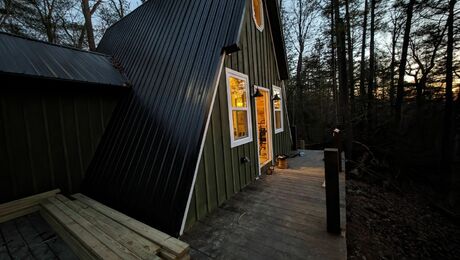Don’t mess up a good thing
Regarding your editor’s note in the last issue (FHB #184, p. 8), titled “The Future of Magazines,” we subscribers value Fine Homebuilding for what it has become: the best building magazine out there. My wife and I fight to see who can grab it first from the mailbox. We just wish there were even more issues each year. While change periodically occurs in everything, be careful. What you have is great. If I want funny, I’ll read comics. What I want is content. Moving the “technical information” to the Internet will not be helpful. I can see indexes and past articles online with a good search tool for looking up things fast—now we have to go through all the past issues, which we faithfully keep—but I will not spend time reading online. I’m not about to have a computer in the bathroom, where Fine Homebuilding often is taken for perusal.
Whatever you are thinking, please do not mess up a good thing.
—Fred Van Magness, via email
Stop with the eco-preaching
I love Fine Homebuilding, but lately, there has been far too much eco-preaching. It’s fine to have articles on green building, given that there are people out there who want that. But spare me the self-righteous hippie crap, like Alex Wilson’s “Down the drain” in the latest issue of Kitchens & Baths (FHB #183, pp. 8, 10, 12), which would have us believe that using water is a sin. Water is the most abundant substance on earth, and it is continuously recycled with no help from man. The article points out that “nobody is making any new water”; that’s because nobody has to. The article says “water belongs to all of us.” No, comrade. The water you buy belongs to you. The water I buy belongs to me. And if I want to bathe daily under a 100-gallon-per-minute shower, that’s nobody’s business but mine.
—Bill Muse, Seattle
Be responsible; go sustainable all the way
I literally stood up and cheered when I read the excellent essay by Alex Wilson on multihead spa showers that bypass federal water-saving regulations in a “textbook example of profligate waste.” My enthusiasm turned to dismay when I got to p. 72 and saw all the multihead shower systems highlighted in full-color glory, with 16 (count them!) manufacturers prominently listed as sources for these water-wasters. Using both articles was insulting to your readers and to both authors. It’s time for your excellent magazine to join the ranks of other responsible publications: Start editing all your content to reflect sustainable practices.
—Giana Cochran, Portland, Ore.
Better sound-control products
Better sound-control products Myron R. Ferguson’s article “The Quest for a Quiet Room” (FHB #184, pp. 55-59) is right on the money as far as the attention to detail that must be taken to achieve high levels of sound control. Our company, Acoustiguard-Wilrep (www.acoustiguard.com), has been in business for 32 years, selling sound-control products. We sell a great deal of the mass-loaded vinyl that Myron recommends, but recently, we’ve discovered two relatively new products that far surpass it.
Acoustic clips (www.pac-intl.com) are rubber and steel isolators that are screwed to studs or joists and hold resilient channel. Green Glue (www.greengluecompany.com) is a water-based damping compound that comes in a caulking tube and typically is used between two layers of drywall.
Both of these products far surpass the acoustic performance of mass-loaded vinyl and are less expensive.
—Bill Wilkins Jr., Mississuaga, Ont.
Author Myron R. Ferguson replies: The main point of my article was to stress the importance of planning ahead and paying attention to details. There just wasn’t enough room to include many more soundcontrol products.
I used some Green Glue the other day and liked it. The acoustic clips are also a good idea because they offer further isolation as well as eliminate the chance of shorting out the steel channel by accidentally putting a screw through the drywall and the resilient channel into the framing.
The cost of granite countertops
Shame on you for misleading the average consumer and possibly a portion of the professional community. In your Kitchens & Baths issue (FHB #183) on p. 53, Rosemary McMonigal states that the homeowners saved $10,000 by choosing laminate countertops over granite. As a natural-stone fabricator, I am appalled by your willingness to publish what certainly must be a fallacy. At an average cost ranging between $65 and $85 per sq. ft. for fabricated and installed granite slab, the total cost for what looks to be less than 40 sq. ft. would be $2600 to $3400—a far cry from $10,000. And the cost of the laminate countertop was not even figured into the savings equation.
I fully support exposing the public to as many design alternatives as possible, but accurate information must be supplied so that consumers can make intelligent choices and not automatically reject materials because of supposed exorbitantly high costs. Your article hurts the stone industry, including fabricators like myself.
—Dan Koske, North Canton, Ohio
Author Rosemary McMonigal replies: You’re correct that accurate cost information is important, so let me clarify. Near Minneapolis, many of the granite selections fall in the $70- to $80-per-sq.-ft. range, but rise to $250 per sq. ft. for exotic and nonstocked stone selections.
For this project, the countertop decision truly was impacted by cost. The amount of countertop was actually 129 sq. ft. of horizontal surface, not counting any backsplash area. The countertops impacted were in the kitchen, the back entry, and the laundry area; the client wanted continuity among all of them.
Initially, we compared the actual laminate and granite selections: Laminate was $20 per sq. ft. x 129 sq. ft. = $2580. Granite was $105 per sq. ft. x 129 sq. ft. = $13,545, plus edge finishing, putting the difference at more than $10,000.
We did end up changing the island to wood, which reduced our savings some.
Low-flow showerheads mean longer showers
Where did the U.S. government come up with the 2.5-gpm (gallon per minute) showerhead flow rate (FHB #183, “Taking Issue,” pp. 8, 10, 12)? It certainly was not from a poll of shower users because anyone who has used a 2.5-gpm showerhead knows that it takes longer to shower with the lower flow. Not living in the United States, I am blessed with a 4.0-gpm showerhead. I have been testing the average time it takes to shower in my 4.0-gpm shower (4.5 minutes) as opposed to a 2.5-gpm shower (10 minutes). The average time for my 2.5-gpm shower tests comes from my stays in U.S. hotels where, I assume, they comply with the government flow rate.
I am an average-size person, and I assume that I take an average shower. If so, the government showerhead doesn’t meet the “save water” objective. At the very best, it is a wash, pun intended. So, it’s just one more brain-dead government intrusion into people’s lives that solves nothing.
—Ken Leader, Japan
Author Alex Wilson responds: Your assertion that using water-conserving showerheads results in longer showers is not unusual, but it might not be correct. The U.S. Environmental Protection Agency recently studied the impact of various water-conservation retrofits on water consumption, and they found that shower length did not increase at all when today’s standard 2.5-gpm showerheads were replaced with 1.75-gpm models. In fact, quite surprisingly, the 96 families studied in Tampa, Fla., Seattle, and East Bay, Calif., actually took, on average, slightly shorter showers. Their 2005 report (Water and Energy Savings from High Efficiency Fixtures and Appliances in Single Family Homes) stated: “It has been hypothesized that the introduction of low-flow showerheads and the subsequent reduction in shower flow rate could cause people to increase the length of time spent in the shower. The data from this study do not support that hypothesis and, in fact, the showering duration actually decreased…”
Now when we get into multiple-showerhead systems that are more about recreation than bathing, it’s a fair bet that shower duration increases significantly, compounding the waste.
Do you really need a 400-amp electrical service?
Reading Alex Wilson’s essay “Down the drain” (FHB #183), I was reminded of another area where a similarly wasteful mentality prevails. Homes today often boast 400-amp electrical services, multiple air-conditioning units, and extravagant lighting schemes. For years, the 200-amp electrical service was deemed the norm in this country because it provides for more than enough electrical capacity for just about any home. Somehow, though, many builders and demanding consumers have gotten away from smart energy use, and instead, the norm today seems to be the installation of as many electricity-consuming devices as possible. Little thought is given to the increased electricity demand this causes, and the resources needed to generate electricity. In this era of limited resources, it seems to me that we should be getting smarter and finding ways to use less instead of more. Sadly, this has yet to happen.
—Tom Kadesch, Damascus, Md.
Shop vacuums: Smaller is better
I found your review of Ridgid’s small 41⁄2-gal. shop vacuum interesting (FHB #184, p. 38). I came to the conclusion a long time ago that unless you are sucking up large amounts of water, a large holding capacity is entirely unnecessary because the filter element plugs up long before the tank is anywhere near full and has to be blown clean. In addition, the 17⁄8-in.-dia. hose is an ideal compromise: not as stiff and awkward as large 21⁄2-in. hoses, but with far more airflow capacity than 11⁄4-in. hoses.
There is one problem, however, with the unique hose diameter. You need to buy special hose tools just for this machine, and Ridgid does not provide a 17⁄8-in. to 11⁄4-in. adapter. This adapter is a must because most portable power tools (like sanders) have a 11⁄4-in. vacuum port. I ended up fabricating my own adapter out of fiberglass cloth and polyester resin, but it took too much time.
One thing you didn’t say was whether Ridgid’s Pro Pack has a blower port. I use the blower feature on my vacuum often and won’t buy another shop vac without one. It’s great for blowing water out of lines. I even use it on my boat to blow water out of the engine and freshwater system when I winterize it.
—Nils Omholt, Sterling Heights, Mich.
Assistant editor Justin Fink replies: Ridgid’s new Pro Pack wet/dry vac does indeed have a blower port, but I’m afraid I wasn’t able to track down an adapter for you.





















